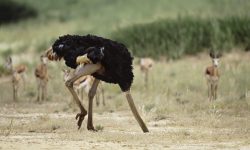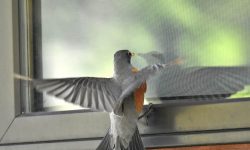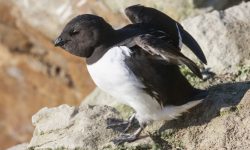The American Robin (Turdus migratorius) is one of the most familiar and widely recognized songbirds in North America. With its bright reddish-orange breast, cheerful song, and year-round presence in many regions, the American Robin serves as a cultural and ecological symbol of springtime and avian adaptability. As a member of the thrush family (Turdidae), it shares several traits with its relatives, such as the Common Blackbird (Turdus merula) and Song Thrush (Turdus philomelos), while exhibiting its own unique behaviors, vocalizations, and habitat preferences.

Identification and Sexual Dimorphism
The American Robin (Turdus migratorius) is a medium-sized songbird, measuring 23–28 cm in length with a distinctive appearance. Adults have a bright orange-red breast, dark gray upperparts, a white lower belly, and a thin white eye-ring.
Plumage and Sexual Dimorphism
While both sexes look similar, males usually show brighter and richer orange breast feathers and darker, glossier heads, especially during the breeding season. Females have paler, duller tones, making the difference noticeable in good lighting. This brightness is linked to diet quality and overall health, which females may assess when choosing mates.
Behavioral Differences
During courtship, males are more vocal, singing frequently from exposed perches to defend territory and attract females. They may also perform display flights with slow wingbeats. Females, in contrast, are more reserved, often spending more time nest-building and feeding.
Males are also more likely to chase intruders or rival males, showing stronger territorial aggression—another clue to distinguish them in the field.
Juvenile Appearance
Juvenile robins are easy to recognize by their spotted breasts and mottled upperparts, which help them blend into their environment. Their plumage transitions into adult coloration within a few months.
Range, Distribution, and Migration
The American Robin is one of the most widespread songbirds in North America. It breeds across nearly all of Canada and the continental United States, and during the non-breeding season, it migrates southward to the southern U.S., Mexico, and parts of Central America.
Flexible Migration Patterns
Unlike many migratory birds with strict seasonal routes, robins exhibit a highly flexible migration strategy. Their movements are primarily influenced by temperature and food availability, especially fruit, rather than by changes in day length. This means that in milder winters, robins may remain in northern regions longer than usual or even year-round.
Flocking and Seasonal Movements
In autumn and winter, robins shift from territorial breeding behavior to communal flocking, often forming large roosts that can number in the thousands. These flocks are nomadic, traveling in search of fruit-bearing shrubs and trees across forests, farmlands, and suburban gardens.
Flocking offers several advantages:
-
Shared information about food sources
-
Greater collective vigilance against predators
-
Dilution of predation risk for individuals
This social behavior during non-breeding seasons highlights the robin’s adaptability and ecological success across diverse landscapes.
Song and Communication
The American Robin is well known for its rich, melodic song, often described as “cheerily, cheer-up, cheerio.” These vocalizations are more than just beautiful—they serve a variety of essential functions in the bird’s daily life.
Functions of Vocalizations
-
Territorial Defense: Males use their songs primarily to establish and defend territory during the breeding season. A strong, persistent song warns rivals to stay away.
-
Mate Attraction: Song complexity, volume, and frequency can signal a male’s health and fitness, helping to attract a mate. Females may prefer males with more varied or sustained singing, which reflects experience and vitality.
-
Alarm Calls: Robins use short, sharp notes—like a “peek” or “tut”—to signal danger. These alarm calls vary depending on the type and urgency of threat, suggesting that robins use a form of acoustic coding to communicate specific risks to others.
Urban Adaptation
In noisy urban areas, robins demonstrate remarkable vocal flexibility. They often adjust the timing, pitch, and volume of their songs to avoid being drowned out by human-made sounds like traffic—a phenomenon known as anthropogenic acoustic adaptation. This behavioral plasticity helps robins maintain effective communication even in heavily modified environments.
Feeding Ecology and Foraging Strategies
American Robins are opportunistic omnivores, with a diet that shifts seasonally:
Spring and Summer
- Their primary food source is earthworms and insect larvae, which provide high protein for nesting and chick rearing.
- Robins use a head-cocking behavior to detect vibrations from moving invertebrates underground—a combination of visual and auditory cues aids in prey location.
Fall and Winter
- The diet becomes predominantly frugivorous, focusing on berries such as hawthorn, juniper, and sumac.
- The robin’s gastrointestinal tract adapts to the higher sugar and fiber content of winter fruit diets, with changes in gut passage rate and microbiota.
They forage primarily on the ground, often running and pausing in short bursts before pouncing on prey. In colder months, they form foraging flocks that scout fruit-bearing shrubs and move cooperatively, with one bird’s discovery attracting others.
Because they swallow berries whole, robins serve as important seed dispersers for many native and ornamental plants.
Breeding Biology and Nest Construction
The American Robin begins breeding early in the year—often as early as late winter in southern regions, sometimes even while snow still blankets the ground. This early start gives robins time to raise multiple broods before the season ends.
Nest Building
Nest construction is carried out entirely by the female, who builds a sturdy, cup-shaped nest using grasses, twigs, and a layer of mud for structure. She finishes it with a soft inner lining of fine grass or other materials to cushion the eggs.
Nests are placed in a variety of locations, reflecting the robin’s adaptability. Common sites include:
-
Tree branches
-
Building ledges and gutters
-
Light fixtures or signage in urban settings
Reproduction and Parental Care
Each clutch typically contains 3 to 5 pale blue eggs. The female incubates them for about 12 to 14 days, during which the male defends the territory and may feed the female occasionally.
Once the chicks hatch, both parents share feeding duties, bringing soft-bodied insects such as worms, caterpillars, and larvae to the nestlings.
In warmer climates, robins often raise two to three broods per season. This high reproductive rate, combined with their nesting flexibility, plays a crucial role in their population stability and resilience across diverse environments.
Development and Fledging
Newly hatched American Robin chicks are altricial—they emerge from the egg blind, featherless, and entirely dependent on parental care. In their first days, they rely on frequent feedings of protein-rich invertebrates, such as earthworms and insects, which fuel their rapid growth and feather development.
By day 12 to 14, most chicks are ready to fledge, leaving the nest despite still being somewhat vulnerable. At this stage, their feathers are partially developed, and while they can flutter, true flight remains limited.
Post-Fledging Period
After fledging, juveniles usually remain near the natal area for another 2 to 3 weeks, during which they:
-
Refine flight skills
-
Practice independent foraging
-
Receive continued feeding and guidance from one or both parents
Interestingly, adult robins often begin a second nesting cycle while still caring for fledglings from the previous brood. In these cases, the male may take over most of the care, allowing the female to focus on the new clutch.
This overlapping parental investment supports multiple successful broods each season and enhances the species’ reproductive success.
Urban Ecology and Adaptation
The American Robin is a model of adaptability in human-altered landscapes. Suburban and urban environments provide a surprising range of opportunities for these birds, many of which they exploit effectively.
Benefits of Urban Living
-
Foraging in Lawns: Short, moist grass in suburban yards mimics the robin’s natural meadow habitat, making it easy to spot and extract worms and insects.
-
Urban Nesting Sites: Robins readily nest on artificial structures such as patios, gutters, windowsills, and light fixtures, demonstrating flexibility in nest placement.
-
Response to Artificial Light: Exposure to light pollution causes urban robins to sing earlier in the morning than their rural counterparts, an adjustment that may help secure territory in noisy environments.
Urban Threats
Despite these advantages, urban life presents significant challenges:
-
Window Collisions, especially during flight in densely built areas
-
Lead poisoning from contaminated soil, particularly in older neighborhoods
-
Increased predation by domestic cats and urban-adapted predators like crows and jays (corvids)
These pressures underscore the need to balance human development with wildlife-friendly practices, as even adaptable species like the robin face ecological trade-offs in cityscapes.
Physiological and Behavioral Plasticity
The American Robin demonstrates notable phenotypic plasticity—the ability to adjust its physiology and behavior in response to environmental conditions. This flexibility underlies its wide distribution and success across varied habitats.
Seasonal and Hormonal Adaptations
Key life processes such as migration and reproduction are tightly regulated by hormonal cues. As day length and temperature change:
-
Hormones like melatonin and gonadotropins help trigger migratory restlessness (zugunruhe) and reproductive readiness, aligning breeding and movement with optimal environmental windows.
Neural and Vocal Flexibility
Robins also display neural plasticity, especially in areas of the brain associated with song production and memory. During the breeding season, males may refine or increase song complexity to enhance mate attraction and territory defense. These seasonal changes in brain function support flexible communication strategies.
Stress Physiology in Urban Environments
Studies show that urban robins often have higher baseline levels of corticosterone, a hormone associated with stress and energy balance. While this may reflect chronic low-level stress from noise, light, or disturbance, it could also represent an adaptive response—helping urban robins remain alert and responsive in unpredictable environments.
Ecological Importance and Interactions
The American Robin plays multiple vital roles in ecosystem function, acting as both predator and prey, as well as a vector in ecological processes like seed dispersal and disease dynamics.
Invertebrate Predation and Soil Health
By consuming large numbers of soil-dwelling invertebrates such as earthworms, beetle larvae, and grubs, robins help regulate these populations. This predation influences soil aeration, nutrient cycling, and microbial activity, indirectly shaping plant growth and soil structure.
Seed Dispersal through Frugivory
Robins are also important frugivores, especially in fall and winter. By consuming berries and soft fruits, they disperse the seeds of over 40 plant species, including both native shrubs and ornamental garden plants. Their movement between habitats allows for broad seed distribution, aiding in plant regeneration and biodiversity maintenance.
Prey for Multiple Predators
Robins serve as a key food source for a diverse group of predators, including:
-
Cooper’s Hawks and other raptors
-
Snakes
-
Raccoons
-
Domestic cats and dogs
This makes them an integral part of terrestrial food webs, transferring energy up the trophic chain.
Role in Disease Ecology
Importantly, robins act as indicator species in disease surveillance. They are especially susceptible to West Nile Virus (WNV) and can carry high viral loads without immediate mortality. As such, they serve as effective reservoir hosts for WNV, enabling the virus’s amplification and transmission via mosquitoes—a dynamic with public health implications in both urban and rural settings.
Survival Strategies and Longevity
Despite exposure to predators, harsh weather, and human-altered landscapes, the American Robin remains one of the most resilient and adaptable songbirds in North America.
Key Survival Strategies
Several traits contribute to the robin’s long-term success:
-
A flexible, omnivorous diet allows it to exploit a wide range of food sources, from earthworms to berries.
-
High reproductive output, with multiple broods per year, helps maintain population stability even when nest losses occur.
-
Behavioral plasticity, such as shifting foraging patterns or altering song timing, enables robins to adapt quickly to changes in food availability, climate, or urban noise.
-
Flocking behavior in winter increases vigilance and reduces individual predation risk.
Lifespan and Longevity
In the wild, most robins live between 2 to 6 years, though many die within their first year due to predation or environmental stress. However, banding studies have recorded individuals living over 12 years, highlighting the species’ potential for longevity under favorable conditions.
This combination of adaptability, social behavior, and reproductive resilience explains the robin’s wide distribution and success across diverse biomes—from forests and meadows to cities and farmlands.
Conservation and Future Considerations
Although currently listed as Least Concern, robins face localized declines due to:
- Pesticide and herbicide use in lawns and agricultural areas
- Habitat fragmentation
- Climate-driven changes in migration and food phenology
Robins may benefit from climate warming in some areas, as it expands wintering grounds. However, mismatches between insect emergence and breeding could disrupt chick survival.
Conservation strategies include:
- Encouraging native landscaping and reduced pesticide use
- Promoting window-safe building design
- Monitoring populations through citizen science platforms like eBird
Conclusion
The American Robin (Turdus migratorius) is far more than a backyard bird. It is a highly adaptable, behaviorally complex, and ecologically influential species. As a symbol of seasonal renewal and an anchor species in ecological networks, it plays critical roles from insect control to seed dispersal. With its ability to thrive in both pristine forests and suburban backyards, the robin exemplifies the resilience and versatility of modern songbirds.






